24 May Safeguards in Conservation: Minimizing Risk and Improving Outcomes
In striving toward a future which supports both sustainable conservation and human well-being, Conservation International (CI) has developed a draft Environmental and Social Management Framework. This framework is being designed to ensure systematic and transparent management of environmental and social risks in CI’s work. The goal is to not only avoid and minimize adverse risks and impacts but also to identify opportunities for improving environmental and social outcomes. To make the vision of a sustainable and equitable future a reality, it is essential that all people have a voice in and share benefits from the sustainable use of land and resources.
Indigenous peoples and local communities frequently play an inextricable role in the sustainable management of their lands and territories, living close to the land and ensuring its use for future generations. CI recognizes this stewardship of nature as an important determinant not only of economic and ecosystem health, but also of human well-being. Once fully implemented, CI’s Environmental and Social Management Framework will help ensure respect for the rights and roles of these communities, and individual women and men, in managing the world’s natural resources.
In this session, CI sought feedback from indigenous peoples, local communities, gender and social experts, and conservation peers on our draft Environmental and Social Management Framework. We explored three central questions:
- What benefits can a safeguard system generate for communities and project participants?
- Can a safeguard system fall short of protecting community and individual rights?
- What steps should CI take to create a safeguard system to meet our goal: that all women and men have an equitable voice in and benefit from the sustainable use of land and resources?



